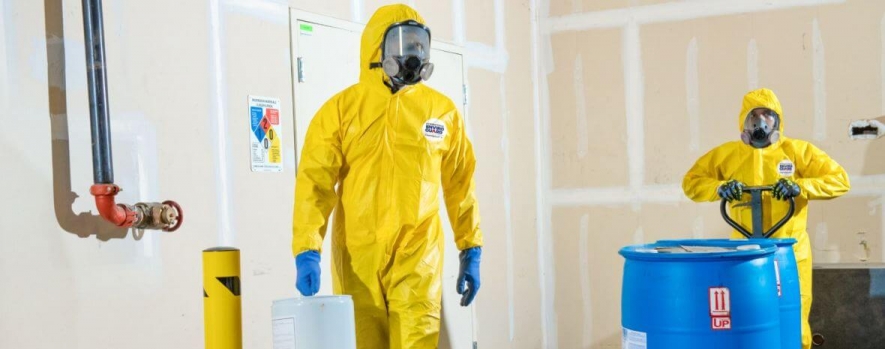
Large quantities of toxic industrial chemicals are manufactured, stored, and transported throughout the U.S. every day. Companies in over 30 different industries utilize toxic chemicals for a wide range of products.
Industrial chemicals are hazardous because of their ability to harm workers in multiple ways. For instance, a chemical in a gas state can be hazardous to breathe and lead to respiratory complications. Likewise, that same chemical can also cause severe skin burns and pain instantly on contact. Furthermore, when mixed with air, water, chemicals, or organic materials, the same chemical can erupt into an explosion or ignite and start a massive fire quickly.
Below, we explore three common industrial chemicals that are highly toxic and what protective clothing you need to adequately shield yourself from the chemicals.
1. Nitric Acid (HNO3)
hydrogen (1), nitrogen (1), oxygen (3)
Nitric acid is a highly corrosive colorless acidic liquid that has the capacity to dissolve heavy metals such as iron, copper, and silver. It is a strong oxidizing agent used in the manufacturing of inorganic and organic nitrates and compounds such as fertilizers, dye intermediates, explosives, and organic chemicals.
Why is it Hazardous?
Nitric Acid can have a suffocating toxic odor. Prolonged inhalation to Nitric Acid can lead to severe medical conditions:
- Chronic bronchitis
- Chemical pneumonitis
- Skin burns
- Eye irritation
- Delayed pulmonary edema
- Abdominal pain
Since Nitric Acid is an oxidizer, it can intensify an already existing fire. A reaction with water or moist air may release toxic, corrosive, or flammable gases into the immediate environment.
2. Sulfuric Acid (H2SO4)
hydrogen(1), Sulphur(1), Oxygen(4)
Sulfuric acid is a corrosive, colorless liquid that is corrosive to both tissue and metals. It has the capacity to char or completely destroy almost any organic matter on contact while starting a fire simultaneously. It is used to make fertilizer, chemical compounds, petroleum refining, and in the production of steel and iron.
Why is it Hazardous?
Exposure to Sulfuric Acid generally occurs one of two ways: long-term exposure to low concentrations (many times undetected) or short-term exposure to high concentrations can result in the following medical conditions:
- Severe skin corrosion & burns
- Eye damage or loss of vision
- Lung damage
- Tracheobronchitis
- Inflammation of the mucous membrane
- Gastritis
- Circulatory collapse
Sulfuric Acid is highly reactive and can ignite combustible materials in an explosive manner. It can emit extremely toxic fumes at high temperatures. A combination with water can create a violent reaction.
3. Hydrofluoric Acid (HF)
hydrogen(1), fluoride(1)
Hydrofluoric acid is a colorless liquid that can cause painful burns. Hydrogen fluoride is used in the production of aluminum, glass etching, and chemical compounds.
Why is it Hazardous?
Acute and chronic exposure to hydrofluoric acid can cause the following medical conditions:
- Respiratory damage
- Pulmonary edema
- Severe painful burns
- Eye irritation and vision impairment
- Dental decay
- Skeletal fluorosis
How You Can Protect Your Employees from Industrial Chemicals
PPE minimizes exposure to both inhalation of and accidents associated with industrial chemicals. Personal protective equipment may include:
- Gloves
- Safety glasses or goggles
- Shoes
- Hoods
- Disposable coveralls
- Earplugs or muffs
- Respirators
- Bodysuits
The selection of personal protective clothing needs to correlate with the type of chemicals that a worker will be exposed to, as well as the overall work environment, job description, and the duration of exposure.
For instance, when working in proximity to hazardous industrial chemicals, an employee should wear disposable coveralls that are designed to protect the entire body against chemical splashes, toxic particles, or some chemical reactions (depending on the intensity of the reaction). Disposable coveralls contain membrane fabric that provides a solid penetration barrier to isolate the skin from the chemical.
PPE and Chemical Resistance
The type of PPE you choose for your employees must able to resist toxic chemicals that can cause permeation, degradation, or penetration of the protective material.
- Permeation. Permeation occurs when a chemical dissolves in or passes through the material at the molecular level. In most cases, the worker will be unaware that the chemical is passing through the material because there is no evidence of permeation.
- Degradation. When a toxic chemical contacts a material, the material undergoes physical modifications. The type and extent of the modification vary depending on the environment. The material shows signs of degradation such as discoloration, swelling, rigidity, or molecular deterioration.
- Penetration. Penetration is the most obvious sign that a chemical has damaged a material. The material will exhibit holes, tears, or punctures. Workers need to be alarmed that the toxic chemical could also penetrate through their primary level of clothing.
Protect Your Employees with ChemSplash® 1
If you are looking for protective clothing for your employees, then contact International Enviroguard. We offer a wide range of protective clothing for workers in all hazardous and environments and industries.
To find out more about our products or to place an order, call us today at (800) 345-5972. You can also send a message on our contact page.